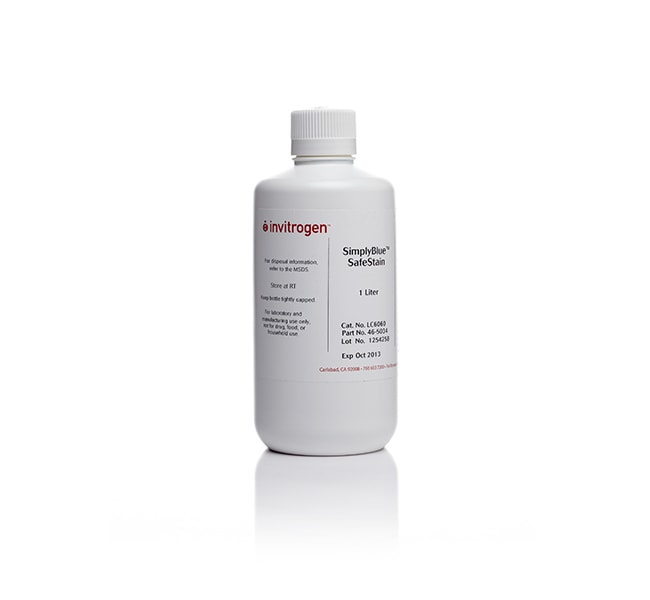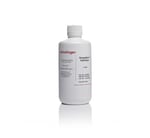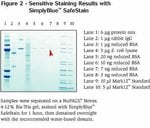Search Thermo Fisher Scientific
SimplyBlue™ SafeStain
| 货号 | 数量 |
|---|---|
| LC6060 | 1 L |
| LC6065 | 3.5 L |
比较所有考马斯染色剂›
易于使用的方案
SimplyBlue SafeStain 方案易于执行,并且可以在不到三个小时的时间内完成。对于更高的速度,可在 12 分钟内完成简单的微波程序。虽然不是必需的,但可使用去离子水进行脱色以实现较高灵敏度,尤其是在进行下游分析时,如质谱分析或者需要水晶般透明的背景时。

Introducing iBlot 3 Western Blot Transfer System
Featuring higher throughput and built-in cooling for consistent protein transfer
Learn more ›
图表


Customers who viewed this item also viewed
文件和下载
安全数据表
常见问题解答 (FAQ)
It is not recommended because the background will be too high. Better alternatives include:
1) Invitrogen Reversible Membrane Protein Stain Kit (Cat. No. IB7710).
2) Coomassie (non-colloidal) staining: stain in 0.1% Coomassie Blue R-250 in 50% methanol for 5 min and destain with several changes of 50% methanol and 10% acetic acid. Rinse with several changes of water, air dry and store for up to 12 months at -20°C. Sensitivity is approximately at the 50-100 ng level.
3) Use SimplyBlue SafeStain (Cat. No. LC6060). The SimplyBlue SafeStain manual has the protocol for staining PVDF membranes, but it is not recommended for nitrocellulose because of high background.
4) Amido Black: same as Coomassie but less sensitive.
5) Ponceau S: same as Coomassie but less sensitive.
6) UV transillumination: place membrane on filter paper after blot is finished and allow to dry at room temperature for about 10 min. Rewet in 20% methanol and view the blot in front of white light while it is still wet; the bands will look more translucent than the membrane. If the bands disappear as the membranes dries, rewet again.
Find additional tips, troubleshooting help, and resources within our Protein Electrophoresis and Western Blotting Support Center.
Coomassie G-250 will give a sharp dye front with both NuPAGE MES and MOPS Running Buffers and is therefore used as the tracking dye in the NuPAGE LDS Sample Buffer.
Bromophenol blue runs more slowly than some peptides with the NuPAGE MES Running Buffer system.
Coomassie G-250 migrates much closer to the moving ion front than bromophenol blue, ensuring that small peptides will not be run too far (e.g., off the gel).
Find additional tips, troubleshooting help, and resources within our Protein Electrophoresis and Western Blotting Support Center.
The Colloidal Blue Staining Kit (Cat. No. LC6025) is best for quantitation by densitometry. You can also use SimplyBlue SafeStain for this application.
The great advantage of SimplyBlue SafeStain is that it is very easy to use and safe.
Find additional tips, troubleshooting help, and resources within our Protein Assays and Analysis Support Center.
Check the cap on the bottle. If the bottles are not tightly sealed, the alcohol can evaporate from the stain causing substantial decrease in stain sensitivity.
Find additional tips, troubleshooting help, and resources within our Protein Assays and Analysis Support Center.
After staining with SimplyBlue SafeStain, use deionized water for the less strongly retained protein bands on the PVDF membrane.
Increasing methanol or ethanol concentrations up to 70% should destain any remaining bands. You can leave the membrane in the destain indefinitely.
Find additional tips, troubleshooting help, and resources within our Protein Assays and Analysis Support Center.



